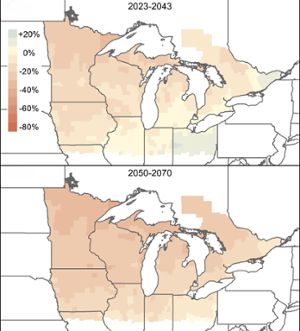Forecasting the future to protect monarchs
The outlook for monarch butterflies isn’t great right now. In fact, the International Union for the Conservation of Nature, or IUCN, just added North America’s monarchs to its list of endangered species.

With news like this, it can be easy to overlook the reasons to be hopeful that we can protect these iconic insects from extinction. But those bright spots are there if people know where to look.
Now, there are forecasts to help guide conservation, thanks to Michigan State University’s Elise Zipkin and her colleagues.
Working with extensive data sets and established models, the team has forecasted which counties in the midwestern U.S. and Ontario, Canada, are most likely to offer the most hospitable breeding grounds for monarchs in the face of climate change. These forecasts, published Aug. 19 in the journal Global Change Biology, can help identify where the greatest opportunities to support monarch conservation may be.

“These projections let us look at how monarch populations will change across the Midwest and say, ‘Here’s where they’ll likely do a little better, here’s where they might do a little worse,’” said Erin Zylstra, first author of the new report and a former postdoctoral researcher in the Zipkin Quantitative Ecology Lab.
The Midwest is an important summer breeding area for eastern monarch butterflies. Over the course of a year — and four generations — monarchs migrate between central Mexico and parts of the U.S. and southern Canada east of the Rocky Mountains.
But between 1996 and 2014, the eastern monarch population has decreased by more than 80 percent. Last year, Zylstra, Zipkin and their colleagues published a paper showing that climate conditions were the major driver of recent declines.
Building on that 2021 study, the team took its understanding of how climate influenced monarch populations since 2004 and used that to forecast what could happen over the next 80 years under a range of climate change scenarios.

“Climate change is a huge global problem that requires nations working together to solve. When we talk about conservation, though, we tend to want to know what we can do in our local communities,” said Zylstra, who is now a quantitative ecologist with the Tucson Audubon Society in Arizona. “If we can find the places where the impacts of climate change aren’t expected to be so bad, those could become the areas where we invest our resources.”
“In general, our research is informed by asking what are the conservation needs,” said Zipkin, senior author of the study and an associate professor in the College of Natural Science’s Department of Integrative Biology. She’s also the director of the Ecology, Evolution and Behavior Program, a pillar of MSU’s overall ecology program, which was recently ranked No. 32 globally.
Zipkin and Zylstra’s latest work was supported by the National Science Foundation and U.S. Geological Survey’s Midwest Climate Adaptation Science Center, which facilitates partnerships between scientists, community leaders and natural resource managers.
“We’re answering scientific questions that we think are important, but we are also working with on-the-ground individuals and agencies that can use our work to implement strategic conservation,” Zipkin said. “The Midwest Climate Adaptation Science Center helps us get our research directly into the hands of those people who are thinking about next steps.”
Another unique feature of the work is how it considers sources of uncertainty and provides quantitative estimates for those, the researchers said. This approach — which explicitly considers what is unknown about the future — can help the research community better understand and utilize the team’s results and models. It also helps researchers identify what’s needed to improve the precision of future forecasts.

For example, unknowns about future climate are the largest source of uncertainty as the team forecasts what monarch populations will look like at the end of the 21st century. But in the immediate future, uncertainties about exactly how specific climate variables influence local monarch population abundances loom large. Collecting more robust, targeted monarch data could thus improve projections in the short term.
In the meantime, Zylstra and Zipkin have presented their best and most data-informed forecasts in collaboration with Naresh Neupane, a climate scientist at Georgetown University. The team forecasted monarch population changes in counties throughout the summer breeding grounds and on the overwintering grounds in Mexico under four different climate scenarios.
In each scenario, the forecasts suggest that the eastern monarch population will continue to decline, which is not surprising given the butterflies’ current trajectory. But identifying the pockets where, locally, populations are growing or holding constant provides hope that the decline can be slowed or reversed.
And if the approach helps save monarchs, it can help with other threatened species, too.
“Monarchs are special. They’re beautiful, easy to identify, widely distributed and they get people to care about conservation in general,” Zipkin said. “Absolutely, with action, we can protect our planet, we can protect other migratory species, we can protect pollinators and we can protect monarchs.”
Banner image: Michigan State researchers have forecast monarch butterfly population sizes throughout the Midwest to show where conservation efforts could have the most impact in the face of climate change. Credit: Dave Pavlik